Washington, D.C. Temporary Plates
Temporary license plates, which are made of cardboard, are issued by the DMV and vehicle dealers for use during short periods for various reasons, today most commonly to allow an otherwise unregistered vehicle to be driven to the city inspection station in advance of being registered. Although sometimes neglected by plate collectors due to their unusual construction and fragile nature, they are representative of legitimate types that warrant just as much attention as their metallic counterparts. An unusual characteristic of these plates is that the city name has always been shown as DISTRICT OF COLUMBIA whereas by early 1969 the change to WASHINGTON, D.C. had been made on plates of all other types.
| Special Use | First Issued: 1951 |
|
 The creation of this registration type was approved by the Board of Commissioners in January 1951, and the enabling regulation is believed to have become effective during that month, which is to say that the first plates, numbered beginning at X-1 and issued in pairs, likely were available for issuance before the end of January. The original fee for these cardboard plates was $1, and they were valid for a period of 10 days. As for their purpose, according to a Washington Star article in which their creation was announced “They might be obtained, for example, by a person who buys a new car at the factory and does not want to buy regular state tags to drive it here, or by a lienholder who has repossessed an automobile here. In their letter recommending the legislation, the Commissioners had pointed out that the present act did not provide for issuance of any kind of temporary tags to persons 'not immediately able to comply with all the requirements necessary to obtain regular identification, or persons upon which it would impose an undue financial burden to obtain regular identification tags for a few hours or days.'”
The creation of this registration type was approved by the Board of Commissioners in January 1951, and the enabling regulation is believed to have become effective during that month, which is to say that the first plates, numbered beginning at X-1 and issued in pairs, likely were available for issuance before the end of January. The original fee for these cardboard plates was $1, and they were valid for a period of 10 days. As for their purpose, according to a Washington Star article in which their creation was announced “They might be obtained, for example, by a person who buys a new car at the factory and does not want to buy regular state tags to drive it here, or by a lienholder who has repossessed an automobile here. In their letter recommending the legislation, the Commissioners had pointed out that the present act did not provide for issuance of any kind of temporary tags to persons 'not immediately able to comply with all the requirements necessary to obtain regular identification, or persons upon which it would impose an undue financial burden to obtain regular identification tags for a few hours or days.'”
 |
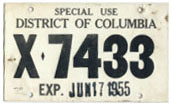 |
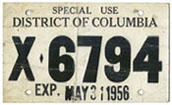 |
1951 |
1955 |
1956 |
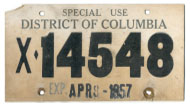 |
 |
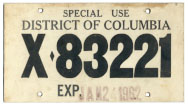 |
1957 |
1958 |
1962
|
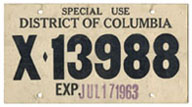 |
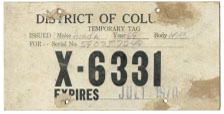 |
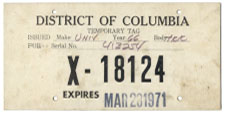 |
1963 |
1970 |
1971 |
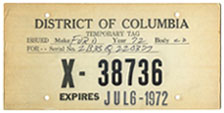 |
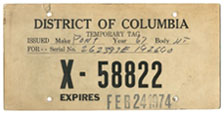 |
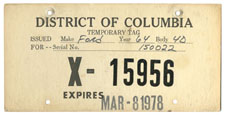 |
1972 |
1974 |
1978 |
Special Use plates differ from temporary plates in that they were issued by the DMV whereas Temporary plates are issued by vehicle dealers. The distinction is displayed in the type name at the top Special Use plates and the different letter prefixes (X vs. DX). Although they do not include the type name, we assume that post-1963 temporary plates with an X prefix are a continuation of this type, which is to say that they are DMV-issued temporary plates.
Shown at the top of this section is the explanatory text that is printed on the back of all Special Use plates. This particular example is plate number X-83221, also pictured above. The current status of this type is unknown, but it appears to have merged with Temporary around 2000, which is to say that the two types were likely viewed as similar enough that having two separate types was probably determined to be unnecessary.
| Temporary | Earliest Known: 1955 |
Current Type Designations: N and NC |
Temporary plates have been issued in Washington, D.C. for over fifty years. If they were issued any earlier than the mid-1950s it was likely not for very long. For years during which Special Use and Temporary plates were both issued, plates of both types include the same instructions on the back, including use of the term "Special Use," providing evidence that that type is the older of the two. Also while both types were in circulation, they could be differentiated by their letter prefixes: Temporary plates, issued exclusively by vehicle dealers, began with DX whereas Special Use plates had an X prefix. Today only the Temporary type remains. Various letter prefixes have been used since early 2001, when the period of validity was 45 days.
Black-on-White Series
No authoritative documentation that indicates when and why changes were made to features of plates of this type is known, so design alterations highlighted here are based upon observation of the plates pictured below. We can see, for example, with plate DX-39287 that drastic changes were made during the second half of 1961 or early 1962. Dimensions of these cardboard plates was changed to 6"x12". More evident, however, is that the size of the registration number was reduced dramatically in order to allow for the addition of spaces in which the name and address of the individual or business to which the plate was assigned was to be written by the issuing dealer. A space was also made for the dealer to identify itself, a task usually accomplished with a rubber stamp.

Perhaps a motorist's name and address was a little too personal for display on a license plate, for by 1965 that data was no longer required. Instead, information about the vehicle, the make, model year, serial number, and body style, were to be written. Shown immediately above is a close-up image of the data section of plate no. DX-66819.
During 1970 the size of registration number characters was reduced again, but the plate size remained at 6"x12". The final year for Temporary plates in the black-on-white format is unknown, but based upon examples shown and information provided on this page it appears to have been between spring 1987 and fall 1992.
 |
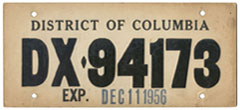 |
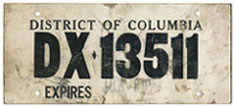 |
1955 |
1956 |
1957 |
 |
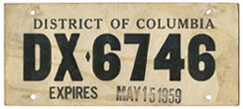 |
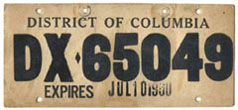 |
1958 |
1959 |
1960
|
 |
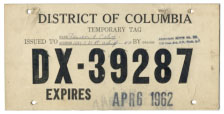 |
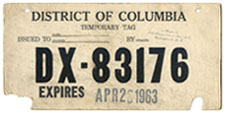 |
1961 |
1962 |
1963 |
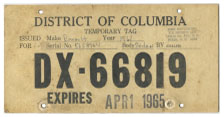 |
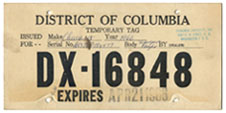 |
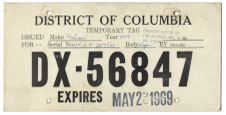 |
1965 |
1966 |
1969 |
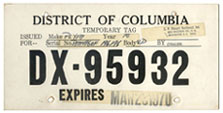 |
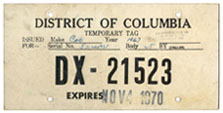 |
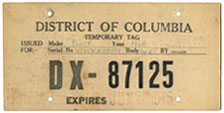 |
1970 - early |
1970 - late |
1975 |
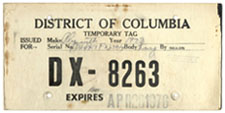 |
 |
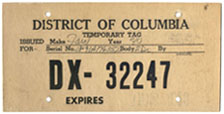 |
1976 |
1978 |
1980 |
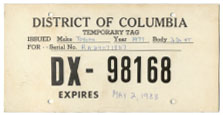 |
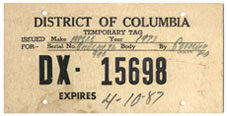 |
||
1983 |
1987 |
Green-on-White Series
One of the most frustrating mysteries about modern D.C. plates is caused by the lack of a year designation on green-on-white temporary plates issued late in the 20th century. The expiration date is indicated with holes punched in the month and date of expiration, but a year designation is unfortunately omitted.
A March 1995 newspaper article about how the DMV had temporarily run out of general-issue auto plates shows a motorist leaving the DMV with a plate of the green-on-white design (although the black-and-white photo makes a positive identification of the plate color scheme impossible), which verifies that this design was in use by the mid-1990s. Plate no. DX 74123 (not shown) has a Sept. 22 expiration date and was acquired by a plate collector in October 1992, suggesting that it may have been issued in that year. We believe that plates of this design were introduced between spring 1987 and fall 1992, and were replaced by red-on-white plates in early 2001, so they are most often associated with the 1990s.
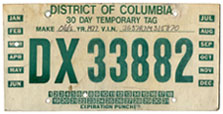

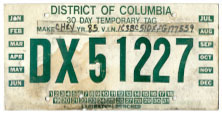
Temporary plates issued beginning in early 2001 feature red printing on a white background, and the year designation again appears. As of spring 2012 the period of validity was 45 days.
The quantity of temporary plates issued decreased beginning in June 2012 as a result of a change in the manner in which certain registration transactions were processed that took effect on May 30, 2012. Until that date, temporary plates were issued when a D.C. resident purchased a used vehicle that needed to be inspected or brought into the District a vehicle registered in one of the states. All vehicles must be inspected before being registered in D.C., and in these two common scenarios before June 2012 vehicle owners had to procure a temporary plate in order to take their recently purchased used and uninspected or out-of-state vehicle through inspection. Since June 2012, however, a set of regular license plates has been issued in these circumstances along with a windshield validation sticker marked "Temporary Registration." The fee is $13. Processing these routine transactions in this manner reduces temporary plate fraud, according to the DMV, and eliminates the need for motorists to make a second trip to the DMV to secure their permanent plates.
Since June 2012, temporary plates have continued to be issued when
- a non-D.C. resident purchases a used vehicle in D.C.;
-
a vehicle belonging to a new D.C. resident has expired plates, to take the vehicle through inspection;
-
a commercial or for-hire vehicle requires inspection and classification by the inspection station before being registered; and
-
in certain other unusual circumstances.
As we identify more of these plates we hope to be able to identify when this style was introduced, but at this time the earliest example we have is no. X-18838, which was issued in mid-2001. It is possible that the use of this letter prefix was a holdover from the green-on-white series, although in more recent years other letters have been used. The order in which single-letter prefixes have appeared on red-on-white temporary plates is as follows:
Prefix |
Approximate Period of Issuance |
X |
early 2001 through late 2003 |
Z |
late 2003 through April 2007 |
K |
April 2007 through May 2011 |
N |
since May 2011 |
The most recent plates of this type feature a pale red image of the D.C. flag in the background. Plates Z 99455 and K 98923 pictured below include this feature, and based upon their registration numbers and expiration dates we can estimate that from mid-2007 through mid-2011 about 25,000 Temporary plates were issued annually during this period.
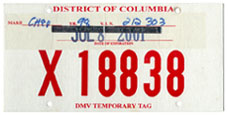 |
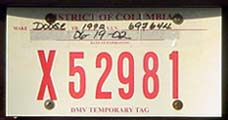 |
2001 |
2002 |
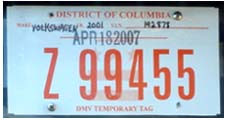 |
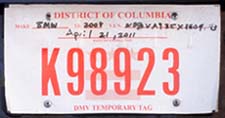 |
2007 |
2011 |
A separate series of temporary plates was introduced sometime around 2008 for issuance by new car dealers, of which there is presently only one in the District, Martens Volkswagen and Volvo. These red-on-white plates are identified by an NC type code embedded in the serial number.
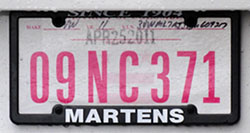 |
||
2011 |
| Motorcycle Temporary | First Issued: unknown |
|

Little is known about this registration type, which is thought to have been introduced not long before the example pictured was issued in 2009. Motorcycle temporary plates are cardboard covered with reflective sheeting, which includes a graphic of the D.C. flag (in gray, not red) in the background. This plate, like permanent motorcycle plates, is 4" high and 7" wide.
|
This page last updated on December 31, 2017 |
 |
|
copyright 2006-2018 Eastern Seaboard Press Information and images on this Web site may not be copied or reproduced in any manner without consent of the owner. For information, send an e-mail to admin@DCplates.net |

